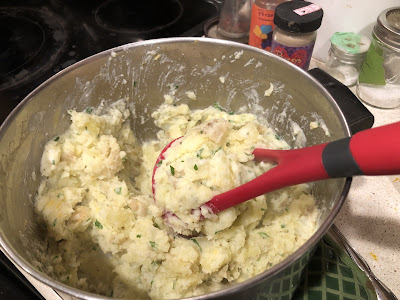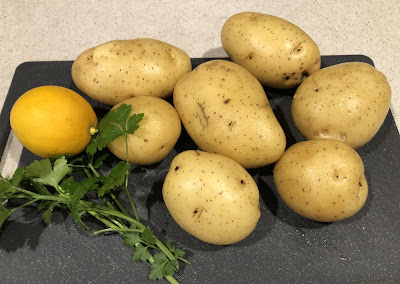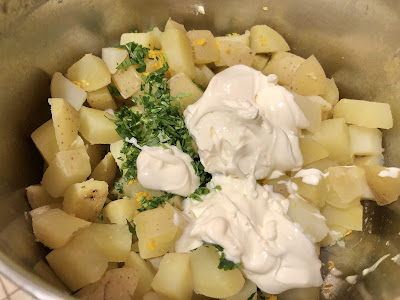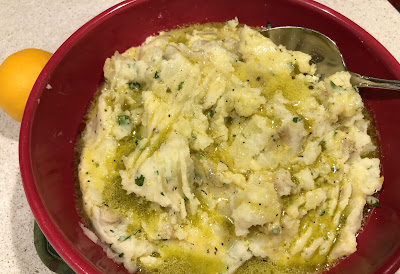
Recipe: Meyer lemon and herbs are key to this side dish

Mashing potatoes by hand creates the perfect chunky
texture. (Photos: Kathy Morrison)
|
March brings many associations to mind -- daffodils, blossoming trees, allergies and asparagus, to name a few. Potatoes definitely are among them, probably because of the link with St. Patrick's Day, as well as spring planting and the transition from winter fare to lighter dishes.
This mashed potato recipe, adapted slightly from a Bobby Flay recipe, fits the bill for a transition dish. It goes very well with turkey meatloaf and roasted chicken, but also would be spectacular with grilled salmon or skewered shrimp. The last of the Meyer lemons is the secret flavor here, working alongside some Dijon mustard and a handful of fresh herbs. Use at least fresh parsley; the oregano and chives are optional or can be substituted with dried versions.
Also, the vinaigrette to pour over the potatoes at the end is entirely optional, I discovered. The mashed potatoes with the crème fraîche, zest and herbs are wonderful on their own; the vinaigrette soaks into the potatoes and adds another layer of flavor.
Note: I like mashed potatoes with a chunky texture, so I didn't peel the potatoes -- the skins are thin, anyway, and this just takes more time. But peel if you like. The size of the dice doesn't matter, as long as the pieces are all roughly the same size for cooking.

produce required for this recipe.
|
Lemon mashed potatoes
Served 4-6
Ingredients:
For the potatoes:
2 pounds Yukon Gold or similar potatoes, peeled (optional) and diced
Kosher salt
1/2 cup crème fraîche or sour cream (or even plain Greek yogurt, thinned with a little milk)
Finely grated zest of 1 Meyer lemon
2 tablespoons chopped fresh flat-leaf parsley
2 teaspoons chopped fresh oregano or 1/2 teaspoon dried
2 teaspoon chopped fresh chives or 1/2 teaspoon dried
Ground black pepper
For the vinaigrette:
2 tablespoons Meyer lemon juice (from 1 lemon)
1-1/2 teaspoons Dijon mustard

Stir the crème fraîche, herbs and lemon zest into the
cooked diced potatoes. |
1/4 cup extra virgin olive oil
Kosher salt
Freshly ground black pepper
1 teaspoon finely chopped flat-leaf parsley
1/2 teaspoon finely chopped fresh oregano (optional)
Instructions:
Put the diced potatoes in a medium pot, cover with cold water and add 1 tablespoon kosher salt. Bring to a boil over high heat, then simmer, covered, until the potatoes are fork-tender, 15-20 minutes, depending on how large the pieces are. Drain well, and put the potatoes back in the pot over very low heat, stirring, just long enough to dry them.
While the potatoes are cooking, make the vinaigrette by whisking together the lemon juice and mustard in a medium bowl, then slowly adding the olive oil, whisking constantly until well blended. Season to taste with salt and pepper, then stir in the 1 teaspoon parsley and, if using, the 1/2 teaspoon oregano. Set aside.

The vinaigrette, if used, is poured over the potatoes
before serving. Pass the rest at the table.
|
To finish the dish, stir the crème fraîche, lemon zest and the herbs into the cooked potatoes in the pot. Add salt and pepper to taste. Gently mash the potatoes with a hand potato masher or fork -- a chunkier texture is desired, so avoid over-mashing or whipping them.
To serve, transfer the potatoes to a warm bowl. If using the vinaigrette, pour about half of it over the potatoes and pass the rest at the table.
Comments
0 comments have been posted.Sacramento Digs Gardening to your inbox.
Sites We Like
Garden Checklist for week of April 21
This week there’s plenty to keep gardeners busy. With no rain in the immediate forecast, remember to irrigate any new transplants.
* Weed, weed, weed! Get them before they flower and go to seed.
* April is the last chance to plant citrus trees such as dwarf orange, lemon and kumquat. These trees also look good in landscaping and provide fresh fruit in winter.
* Smell orange blossoms? Feed citrus trees with a low dose of balanced fertilizer (such as 10-10-10) during bloom to help set fruit. Keep an eye out for ants.
* Apply slow-release fertilizer to the lawn.
* Thoroughly clean debris from the bottom of outdoor ponds or fountains.
* Spring brings a flush of rapid growth, and that means your garden is really hungry. Feed shrubs and trees with a slow-release fertilizer. Or mulch with a 1-inch layer of compost.
* Azaleas and camellias looking a little yellow? If leaves are turning yellow between the veins, give them a boost with chelated iron.
* Trim dead flowers but not leaves from spring-flowering bulbs such as daffodils and tulips. Those leaves gather energy to create next year's flowers. Also, give the bulbs a fertilizer boost after bloom.
* Pinch chrysanthemums back to 12 inches for fall flowers. Cut old stems to the ground.
* Mulch around plants to conserve moisture and control weeds.
* From seed, plant beans, beets, cantaloupes, carrots, corn, cucumbers, melons, radishes and squash.
* Plant onion sets.
* In the flower garden, plant seeds for asters, cosmos, celosia, marigolds, salvia, sunflowers and zinnias.
* Transplant petunias, zinnias, geraniums and other summer bloomers.
* Plant perennials and dahlia tubers for summer bloom.
* Mid to late April is about the last chance to plant summer bulbs, such as gladiolus and tuberous begonias.
* Transplant lettuce seedlings. Choose varieties that mature quickly such as loose leaf.